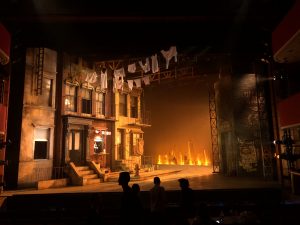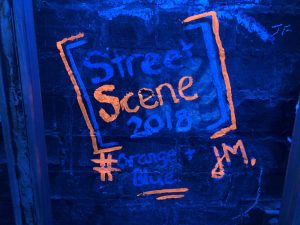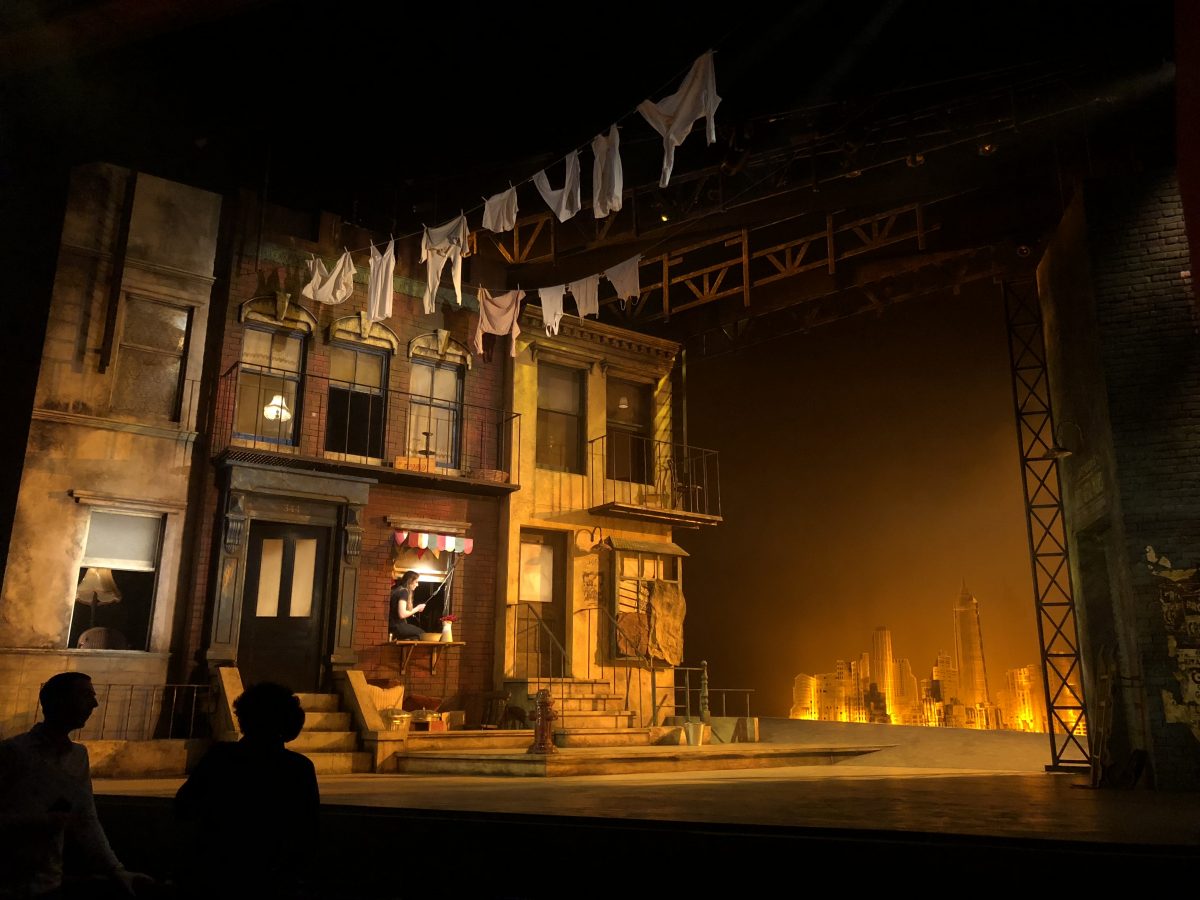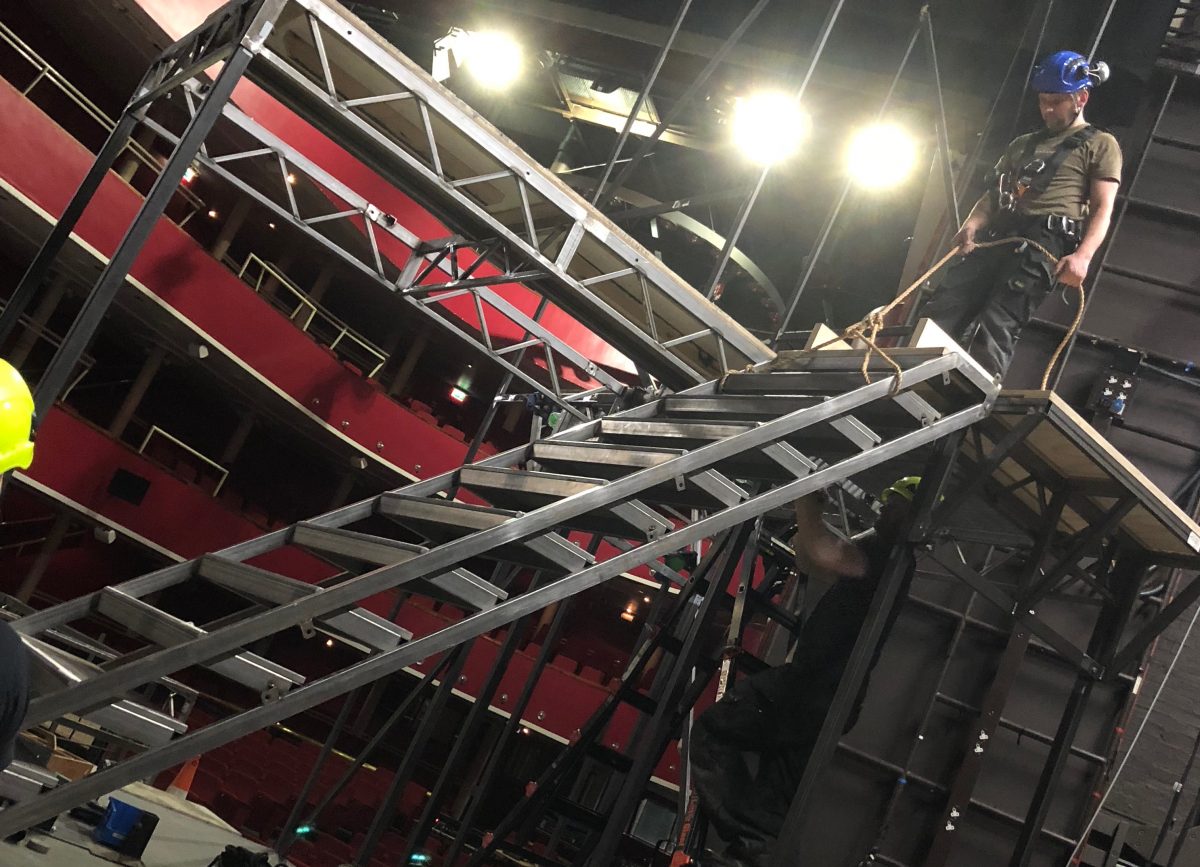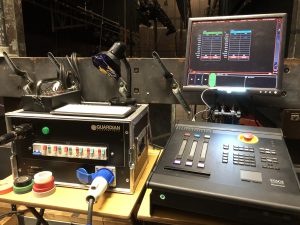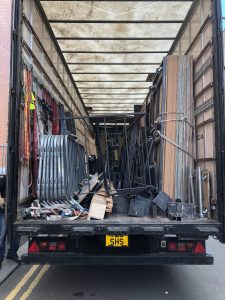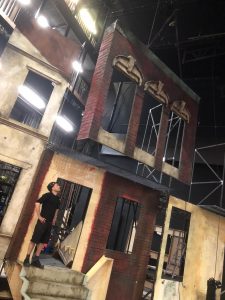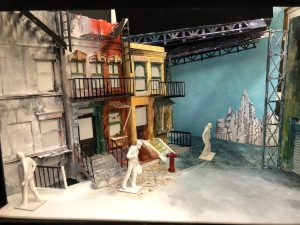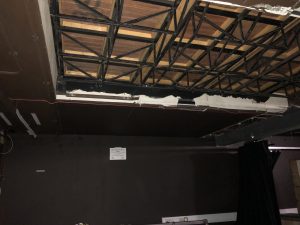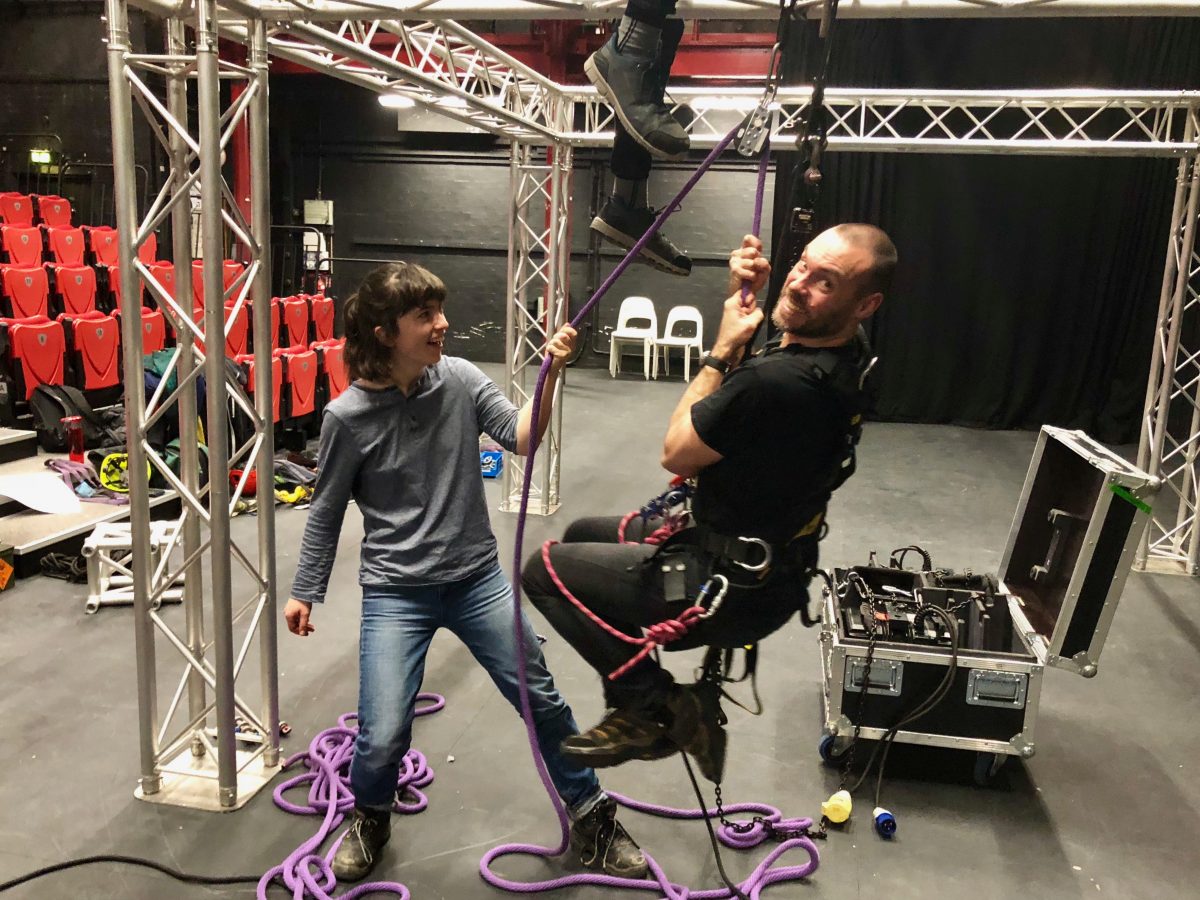There’s a positivity to classes. That is to say that we go through a year and a half of this degree craving them, having them lauded to us as some form of golden city on a hill where all of our desires shall be answered, our intelligence exasperated, and our wisdom tried until we are shaped and hammered into practitioners worthy of the shows we run and the degree we earn. Of course, nothing could live up to this hype and for many these sessions would prove more disappointment than enlightenment. I, however, found them blissful; a chance to not only listen and absorb information from lecturers, challenging and questioning in order to expand my knowledge but a time to embark on my own research to the point that PTM almost felt like a real university degree. Almost. The notes I have taken and the texts I have had the time to analyse have deepened my understanding of stagecraft greatly and have left me with solutions to problems that I am almost certain to face on future shows. Turns out, this degree really is what you make of it. If you will yourself to succeed, and take the steps to do so, you can have a pretty fun time in the process.
Of all the things I’d expected to start the block of classes with, a sit-down talk with Steve and Malky wasn’t one of them. Over the course of four hours we spoke through a multitude of different aspects of Technical Stage Management as a specialism; the role of the TSM, how to cost a show, how to run and utilise our teams, and what our coping mechanisms should be if and when something went wrong. It was remarkably relaxing – at least until the hour and a half where we debated over what our third-year show allocations would be. It also gave us a chance to ask the questions we don’t usually get time to cover – what to actually discuss at a White Card, what are we expected to provide our teams and our shows as Heads of Department – and for Steve to outline his expectations and assessment points; these taking the form of an electrics exam, a Vectorworks exam (obviously), and a series of TSM specific tasks and challenges, our responses to which we would be graded on.
Our first practical session – basics rope access and rigging. After constructing a truss box in the Chandler and hanging a couple of safety lines we spoke and fumbled through open basket rigging, harness work, and the basics of how to ascend and descend a set of ropes. As someone who had never undertaken any kind of access work before, this exposure – out-with the stresses of a show environment – demonstrated the clear benefit that a teaching block at this point in the degree has, and just how much of a strain work like that actually takes on you. It also meant that we had the chance to go slow, to get things wrong, and ask questions about the methods and why they work. Understanding why I am undertaking a task will have it make so much more sense to me, as the methodical reasoning is what makes the actual process become muscle memory; like clipping a counterweight bar, or keeping your loose shackle on the opposite side as your live’s pin. The first conclusion of classes had been reached – aerial rigging may be fun, but it’s damn taxing.
And then came the sit-down sessions, the first being our electrics classes delivered by Christoph and Maciej. The first couple of PowerPoints were essentially a recap of first year; looking at plugs, how electricity works, how to respect working with it, 3 Phase power, and electrical load calculations. We were then given a worksheet with an array of sound and lighting equipment and – through Googling manuals and translating aspects of them from German – we worked out how much power we’d need to make our rig work. Needless to say, the natural Production Electricians in the class found this slightly more engrossing than those of us who aren’t though, on the whole, it was a beneficial exercise. Soldering came next, a class that taught me the true extent to which my hands shake under pressure. Unlike my experience creating the neon sign for ‘Balm in Gilead,’ I avoided melting any of the plastic surrounds of the connections (a personal success), though the two connectors of my XLR did end up the wrong way around. As much as this was not – and still is not – my strongest skill, it was nice to get in the extra practice, along with instructions on wiring several different kinds of plugs and creating jumps that would then actually become venues stock. The afternoon session was run by Dave, and covered PAT testing; what it’s used for, how to complete it, and why – in his words – it’s bullsh*t. This was actually a really interesting session – though it seemed few others found it so – and concluded a day which had developed my, until then, limited electrics knowledge to the point that I felt I could plug up a basic rig without anything blowing up in my face. If that doesn’t constitute success, I don’t know what does.
Having already sat through a tax class delivered by an accountant who had visited us for one of our Monday morning sessions, the first half of Yvonne’s session added nothing new in terms of information. The second, and more interesting part of her seminar, concerned show budgets, how to fill in a budget reconciliation, and how to manage aspects of our show money like petty cash, PECOS orders, and reimbursing our crew – or ourselves – for fuel. This kind of information was very useful to know, particularly as some of us had struggled to prep this paperwork for previous productions, or had been shortchanged and resented Stage Managers who had got it wrong. As much as I would have loved to have stayed for the talk about Equity membership, it was only relevant to Stage Management students, with the BECTU class the following Monday covering all other disciplines. With that our whizz through of all things money related – and our only class with Stage Management – was concluded.
And then came Steve’s rigging class. Truth be told, I’m not sure how well I would have survived in this session had it not been for Malky’s introductory class in September, which covered all the basic aspects of load distribution and calculation. It was from that point that Steve began, under the impression that everyone had a basic knowledge of what load calculations were, what they were used for, and why they were so important. We were given our formulae list, as well as a copy of the H30V page from the Prolyte black book, and a set of problems to solve. Unlike Malky’s class, there was no physical representation in front of us so we could double check our calculations for accuracy. What it did mean, however, is that we had the chance to churn out equation after equation until it felt like mathematical muscle memory. Despite a few arguments about the ‘negligible difference’ between a centred and slightly off centre load (an argument I ended up winning) the class was – though long and quite slow – pretty enjoyable. But then again, I’m clearly the kind of nerd it appealed to. Once again, it’s this time dedicated to theory and rote learning, and the safe environment to make mistakes, that make classes valuable – because there is no doubt it’ll come in handy later on.
One major perk of the classes timetable was the fact that it was sparse. Sessions ran from half nine till five, Monday to Friday, with days often omitted altogether for personal study. I opted to take this time to start my book report assignment early, reasoning that – even if I didn’t like the first book I picked up – I’d have enough time to read a couple more and make an educated decision on which one I ended up presenting. The first book I read was ‘The Stage Rigging Handbook’ by Jay O Glerum. This text was a handbook for the 1980s stage tech, and read as such, with very informative chapters on how to properly rig and counterweight hemp sets, how to operate arbor counterweighted bars and resolutions to the day to day issues a stage tech would face. Though it was an interesting read and provided me with a basic understanding of how to fly a show without needing hands-on exposure time, it was hardly the most thrilling book to do a presentation on. So, I decided to keep the notes I’d taken for my own reference and move on. The next book I picked up was ‘Stage Flying – 431BC to Modern Times’. This went in completely the opposite direction structurally, reading more like a novel than a textbook. The issue with this text was that it didn’t really give direction, just history. From the ancient Greeks to ‘Flying by Foy’ it covered how and why flying was used in theatrical spectacles and the different methods that were used to make people and objects levitate. As it would turn out, Daryl would analyse this book for his Pecha Kucha talk – so it’s likely for the best that I didn’t choose it for mine.
The book that I finally settled on was ‘Automation in the Entertainment Industry’ by Mark Ager and John Hastie. Knowing that we would return to automation classes after the Easter break, and that all other TSMs in the year either had operated our in-house automation system in a show or had a basic understanding of its working, this text seemed like a good option to study, as I hoped it’d give me a vague clue of what I was doing and how the system worked. Glerum’s book had turned me against automation and showed that practically every effect could be achieved with ropes and weights if you wanted to. What Ager and Hastie’s book showed was automations’ benefits, how it worked, how to design a system for your show, and reasons why shows choose to use automation over conventional methods. Though it was a lengthy read, I came out with enough notes and knowledge to stumble through my Pecha Kucha – and get an A1 in the process. The book did achieve its aim, gifting me an appreciation for why automation is used and some of its benefits – but not at the expense of disregarding the quirks and the benefits of a rope system. It’s this balancing act and ability to pick the best system the, I believe, makes you the best kind of TSM – not stuck in the past, but not ignoring tried and tested methods; the perfect middle ground.
The automation classes themselves turned out to be more of a whizz around on the grid than an in-depth induction. Steve spoke us through the components of the system, the basics of the desk and how to program, and gestured to the manual should we require any more in-depth answers to our questions. As it turned out, I was one of the few who had re-positioned the spreaders before, so I wasn’t completely lost. With the information I’d read up on, I could start to connect the dots between learning about a system and actually using it. I had a quick play on the desk, though let those in the class who were visibly more keen to play with the system a majority of the time with it. Whatever time I wasn’t on the desk was spent on the rope lines on the other side of the stage, learning how to scale one set and pass to another, having my asthmatic body try and catch up with my willpower. Overall, I ended up with a basic grasp of our automation system, it’s limitations, and how to tell it what I wanted it to do. Anything else that came up – as it would on the Opera to follow – was only a flick through the manual or a text to James away from being resolved.
During our round-table chat at the beginning of the block, Steve had mentioned his desire to set us an exercise where we would take a hypothetical effect that a designer wanted to put into their show, cost it, and write the methodology of how we would rig and operate it. The idea he came up with involved three flats, forming a box set – one on the back wall, and two others running US to DS. However, the set would completely change during the interval, and all three walls would have to fly out in full view of the audience. Also, due to space consideration, the two side flats had to rotate ninety degrees as they flew out, so as to be parallel with the setting line. It was this effect which we would have to look into achieving.
The first stage of this was writing a method statement, costing it, and working out how the hell to make it happen. My first port of call was the Yale University books that Steve had used as the original inspiration for ‘Paperclip’. I would soon discover that this was a rather good first idea, as the entire methodology of how to make a flat rotate as it flew was listed in detail on page ten. However, when looking at it more closely, I began to spot the issues with their proposal. I couldn’t visualise this method, as written, being successful. However, using this as my jumping off point I set about devising a similar alternative – one with four lines, attached to the two corners of the flat and diverted up through pulleys in the bar, to the grid, then down to flys. Two lines would act to tension the piece at 90 degrees and would slacken as it flew out. The others would be weighted to take up the tension as the other pair slackened, pulling the flat around on a swivel at the top. I made some videos, did some drawings, and then submitted this proposal feeling quite pleased with myself. That was until Steve gatecrashed a session we were enjoying with Ali Low – Technical Stage Manager of the National Theatre of Scotland – and revealed that we would be rigging our solutions in reality in the Ath in two weeks time. I don’t think any of us liked this little surprise, not least because the solutions involving automation threatened to tear holes in the grid. However, one by one, we would go on to rig our idea watching every solution work – to a degree – then giving feedback on what could’ve been improved. Surprisingly, my concept actually worked, though the process resulted in some interesting realisations. One – planning is great, but you need to be able to communicate it well to your team or it counts for nothing. I didn’t communicate well and we suffered because of it. Fully describing the plan before sending my team away to where they needed to be would have helped, as would explaining every detail till they knew exactly what was meant to happen. Two – though something may seem time-consuming now, it’ll be more time consuming when it goes wrong. We could have spent five minutes more fixing the lines on the ground, but we didn’t, and we spent fifteen minutes fixing it from the tallescope. And three – trust in the ability and ideas of those around you, don’t fear them. The help I got from the other TSMs was great, everyone wanting to collaborate with everyone else’s idea to make it work. We felt like a team, and it was really really nice.
So, classes finished. Just like that I was labelling a flyrail and flying a fit-up like nothing had happened. Except now I felt prepared for the shows that would follow, and that I knew at least a little about the job I was expected to do. I feel ready, and it feels good.
